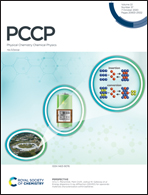Steric clash in real space: biphenyl revisited†
Abstract
A textbook case of twisted structure due to hydrogen–hydrogen steric clash, the biphenyl molecule, has been studied in real space from a new perspective. Long-term discrepancies regarding the origin of the steric repulsion are now reconciled under the NCI (Non Covalent Interaction) method, which reflects in 3D the balance between attractive and repulsive interactions taking place in the region between the phenyl rings. The NCI method confirms that the steric repulsion does not merely come from the H–H interaction itself, but from the many-atom interactions arising from the Cortho–H region, therefore providing rigorous physical grounds for the steric clash. This method allows a continuous scan of all the subtle changes on the electron density on going from the planar to the perpendicular biphenyl structure. The NCI results agree with other topological approaches (IQA, ELF) and are in line with previous findings in the literature regarding controversial H–H interactions in steric clash situations: H–H interactions are attractive, but repulsion appears between (Cortho–H)⋯(Cortho–H), raising the intraatomic energy of the ortho H. ELF is also used to support these conclusions. Indeed, deformations are observed in compressed basins that allow to visualize the intraatomic effect of steric repulsion. These results can be easily extrapolated to systems with similar topological features in which steric clash is claimed to be the reason for instability.



 Please wait while we load your content...
Please wait while we load your content...